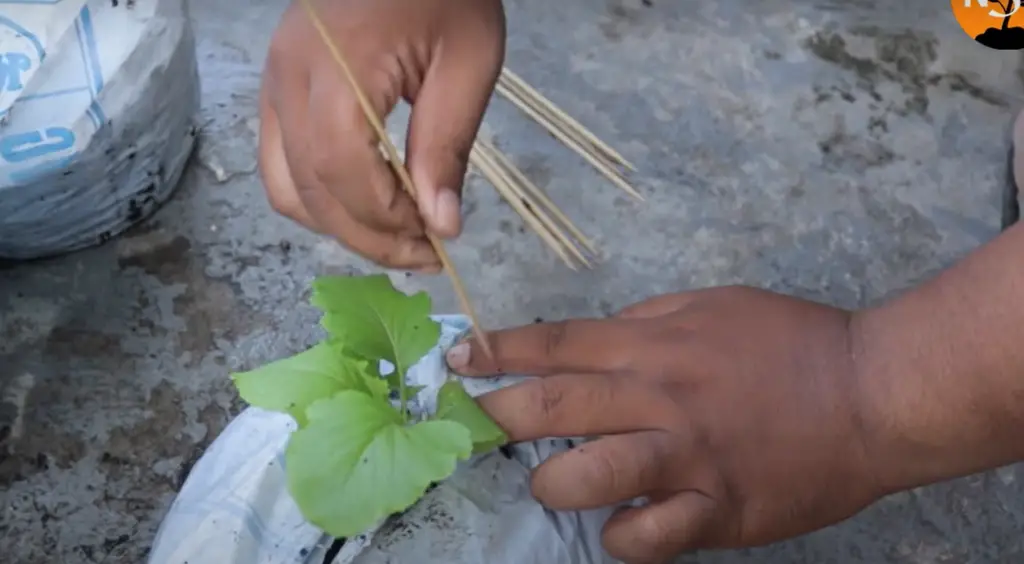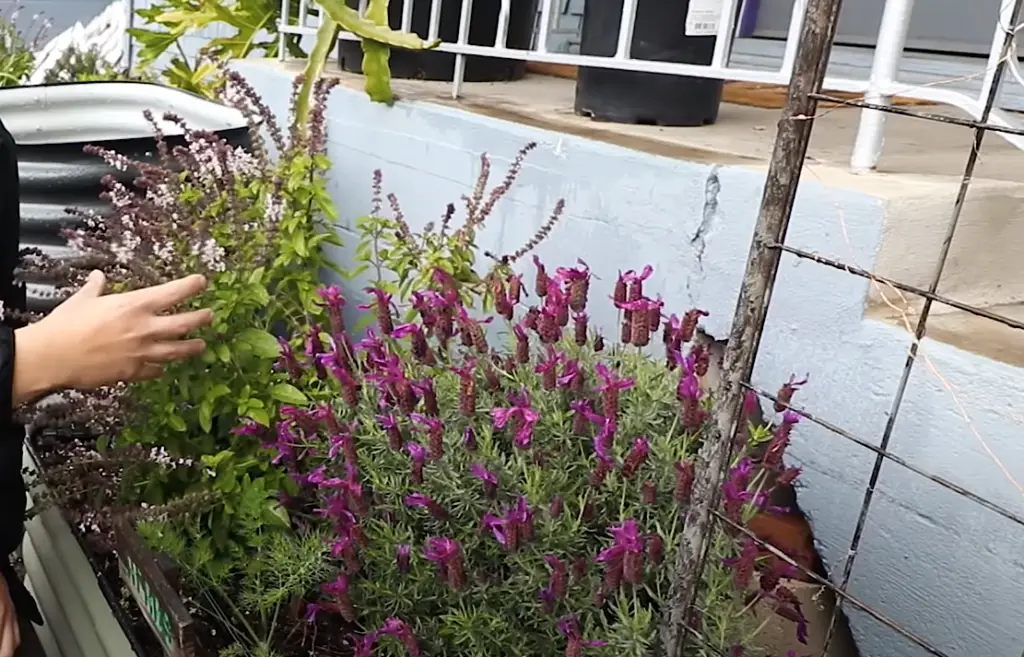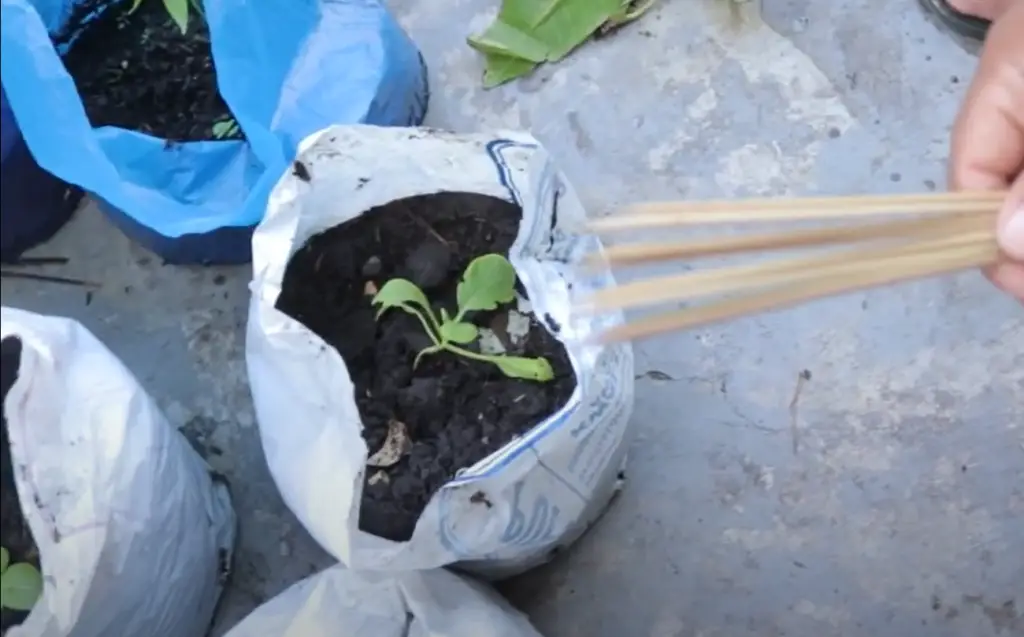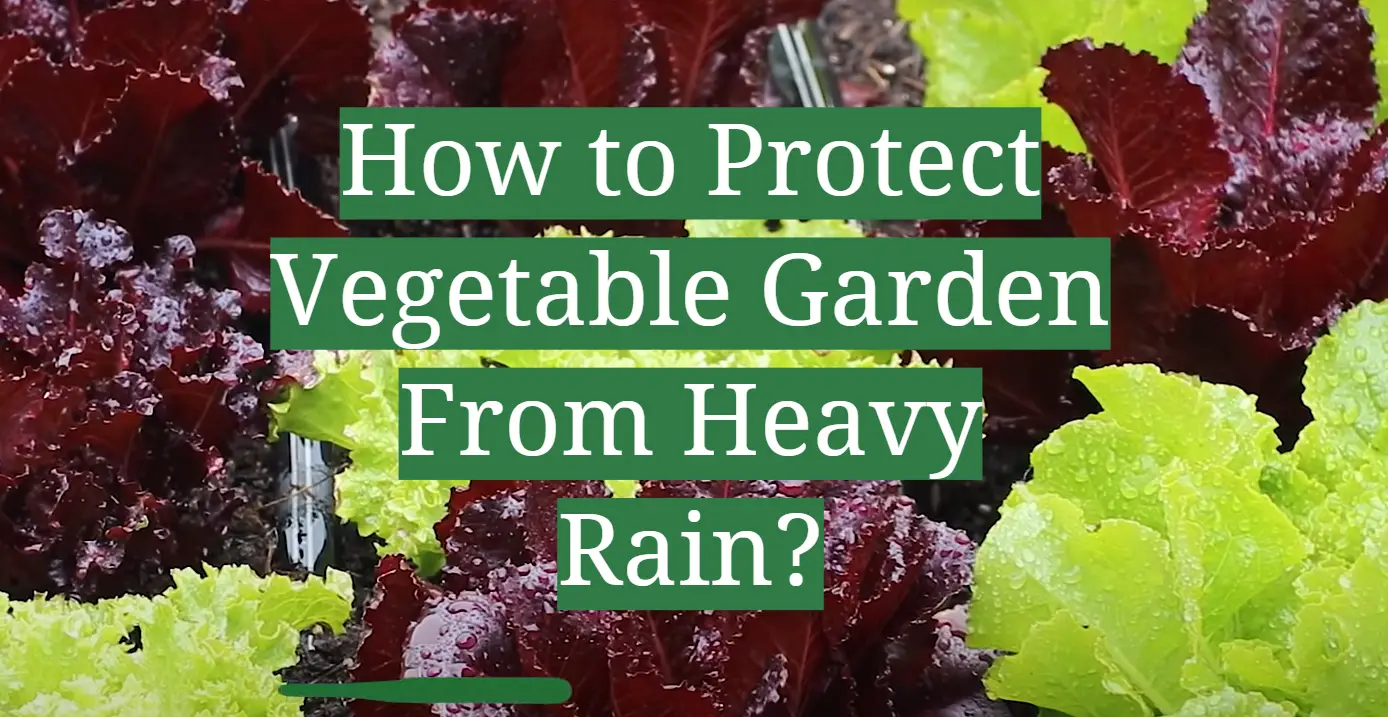Do you have a vegetable garden? If so, you know that keeping it well-protected from the rain is essential if you want your plants to thrive. In this article, we will discuss some tips on how to protect your garden from heavy rain. We’ll cover everything from choosing the right materials to using trenches and berms to keep your plants safe. So read on for all the information you need to keep your vegetable garden dry!
How To Prevent Plant Damage From Heavy Rain
One of the best ways to protect your plants from heavy rain is by using a tarp. Tarps are great because they can be easily removed when the sun comes out and they offer protection from both the sun and the rain. If you don’t have a tarp, you can also use plastic sheeting or even newspapers to create a makeshift cover for your plants.
This way, if there is flooding, the water will not damage the roots of your plants. Pots and containers also make it easy to move your plants around if you need to find a drier spot for them.

Finally, one of the best ways to protect your plants from heavy rains is simply to choose plants that are known to be more resistant to rain damage. Some examples of rain-resistant plants include succulents, cacti, and certain types of palms. By choosing these types of plants, you can rest assured knowing that they will withstand heavy rains much better than other types of plants.
Remove damaged limbs and shoots
The first step is to remove any dead, broken, or damaged limbs and shoots. This will help the plant to recover from the storm damage and prevent further damage.
Next, cut away any branches that are hanging over your garden. These can be a hazard during a storm and can also cause damage to your plants.
Finally, trim any leaves that are touching the ground. These can trap moisture and cause rot.
After you have removed all of the debris, it is time to start repairing the damage. First, check for any cracks or holes in the trunk of your plants. These need to be filled in with a tree sealant or putty.
Next, check the roots of your plants.
Spread a plant fabric over your garden
One way to protect your vegetable garden from heavy rain is to spread a plant fabric over it. This will create a barrier between the rain and your plants, and will also help to keep the soil in place.
You can find plant fabrics at most garden centers or online. Be sure to choose one that is breathable and has good drainage so that your plants don’t get too wet.
Another option is to use tarpaulin or plastic sheeting. However, this should only be used as a last resort as it can cause condensation which can damage your plants.
If you live in an area with particularly heavy rains, you may want to consider building a raised bed. This will help to keep your plants out of the mud and also make it easier for you to access them.
Use buckets or pots to cover individual plants
This is probably the most common and easiest method to keep your plants safe from heavy rain. All you need is a bucket or pot for each plant, and you can simply place them over the top of the plants when it starts raining.

Make sure that the buckets or pots are big enough that they won’t blow away in strong winds, and that they’re not too heavy so that they crush the plants. You might want to consider using plastic pots or buckets so that they’re lighter.
Another option is to use inverted umbrellas as plant covers. This can be a good option if you have a lot of plants, as it will be cheaper than buying individual pots or buckets. Simply open the umbrellas and place them over the plants.
Stake your plants
One way to protect your plants from heavy rain is to stake them. This will help prevent them from being uprooted or knocked over by the force of the rain. You can use anything that will provide support, such as sticks, rocks, or even old tires. Just make sure that whatever you use is sturdy enough to withstand the wind and rain.
Another benefit of staking your plants is that it can help promote drainage. By elevating your plants off the ground, you allow water to drain away from the roots more easily. This can be especially helpful in preventing root rot, which can be caused by too much moisture around the roots.
Avoid planting crops that can’t handle a lot of water
Some vegetables are more delicate than others and can’t handle being waterlogged. Avoid planting these varieties in areas that tend to flood or have standing water after rainstorms. Instead, choose hearty plants that will withstand heavy rains without getting damaged. Some examples of tough veggies include:
- Kale
- Swiss chard
- Collards
- Mustard greens
- Cabbage
- Broccoli
- Brussels sprouts
- Turnips
By choosing the right plants for your garden, you can protect your vegetables from heavy rains and ensure a bountiful harvest.
Drainage
Making sure your vegetable garden has adequate drainage is one of the most crucial things you can do to safeguard it from heavy rain. Otherwise, all that water is going to pool around your plants and roots, which can lead to problems like root rot.
There are a few different methods for alleviating waterlogging in the garden. One is to make sure the soil is loose and not compacted. You can do this by aerating it regularly with a pitchfork or other tool.
Another way to improve drainage is to add organic matter like compost or manure. This will help create pockets of air in the soil that will allow water to drain more quickly.

You may also create raised beds for your veggies. This will help the water drain away from the roots of your plants. Make sure they’re at least six inches high so the roots don’t get saturated.
Finally, you can install a drainage system like French drains or catch basins. These are usually best left to a professional, but they can be very effective at keeping your garden dry during a heavy rainstorm.[1]
How to stop soil erosion from your vegetable garden
There are a couple of things you can do to stop soil erosion in your vegetable garden.
Lay mulch on your plant base
Mulch is a layer of material (usually organic) that you spread over the surface of your soil.
Mulch helps to protect the soil from erosion by:
- Slowing down the rate at which water moves across the soil’s surface
- Keeping the soil cooler in summer and warmer in winter
- Adding organic matter to the soil as it breaks down
You can buy mulch from most garden centres, or make your own by composting kitchen and garden waste.
Plant cover crops in the bare areas
Cover crops are plants that are grown for the purpose of protecting the soil.
They help to:
- Reduce erosion by stabilizing the soil with their roots
- Add organic matter to the soil as they break down
- Improve drainage by aerating the soil
You can sow cover crops in autumn or spring.
Stop runoff by planting shrubs and trees in the upland areas
Runoff is the water that flows across the surface of the soil when it rains.
Upland areas are the parts of your garden that are higher than the rest.
By planting shrubs and trees in these areas, you can help to:
- Slow down the flow of water
- Infiltrate water into the soil
- Reduce erosion
Some good plants for runoff control include willows, alders, and pines.
Get extra cover from crop residue
One way to give your garden some extra protection against heavy rain is to leave crop residue on the soil surface. This can help reduce erosion and keep soils in place. It can also help absorb some of the impact from rainfall, which can protect your plants’ roots.
This will help keep the soil moist and cool, and can also provide some nutrients for your plants.[2]
How to improve drainage in your garden
One of the best ways to protect your garden from heavy rain is to improve the drainage. If you have poor drainage, water can pool in your garden and damage plants.

There are a few things for improving drainage in the garden:
- Install a French drain: A French drain is a type of perimeter drain that can be used to collect and redirect water away from your garden.
- Create raised beds: Water will drain away from plants more quickly if the edges of the beds are raised.
- Add organic matter: Adding organic matter such as compost or mulch to your soil can help improve its ability to absorb and drain water.
Here are some of the methods for improving drainage in your garden.
By cutting a drainage trench at the end of the row
This allows water to drain away from your plants more easily.
To do this, simply dig a trench at the end of the row and fill it with gravel or sand.
Add ditches between crop rows
This will help to drains water away from the roots of your plants and prevent them from being waterlogged.
Another way to protect your garden is by covering it with a tarp or plastic sheeting when there is a chance of heavy rain. This will help to keep the soil from getting too wet and will also provide some protection for your plants from the wind and rain.
Use dikes to redirect water around the crops
If you live in an area with a high water table, consider building dikes to direct water around your crops. Dikes can be made from straw, wood chips, or even sandbags. By redirecting the flow of water, you can prevent your plants from being inundated and drowned.
Building raised beds
Raised beds allow excess water to drain away quickly, preventing your plants from becoming waterlogged and ensuring they have access to the oxygen they need to stay healthy.
Use rot-resistant wood like cedar or redwood for the frame – this will prolong the life of your bed and prevent it from rotting in wet conditions.
Once you have your raised bed built, fill it with a mix of topsoil, compost, and sand. This mixture will help to ensure good drainage while still providing your plants with the nutrients they need to thrive. You can then plant your vegetables as usual, making sure to water them deeply but less frequently than you would if they were in a traditional garden bed. [3]
How to recover after rains
After the rains have passed, it’s time to start thinking about recovery. The first step is to assess the damage. Check for drowned plants, and pull them up immediately. Next, check your soil drainage. If water isn’t draining away quickly enough, you may need to add some organic matter to improve the drainage. Finally, give your plants good watering so they can recover from the stress of the heavy rain.
Monitor your plants closely
Once your plants have recovered from the heavy rain, it’s important to monitor them closely. Check for signs of stress, such as wilting leaves or stems. If you see any problems, take steps to correct them immediately. By taking good care of your plants, you can ensure that they’ll be able to withstand future heavy rains.
Prune damaged crop sections
After the rains have passed and your plants have recovered, you may need to do some pruning. If any of your plants were damaged by the heavy rain, cut off the affected leaves and stems. This will help encourage new growth.
Pruning can be a difficult task, but it’s important to do it correctly if you want your plants to recover fully. Follow these tips, and you’ll be on your way to a healthy garden in no time.
Repel slugs from the crops
Slugs and other pests can be a big problem in gardens, especially after heavy rains. They’re attracted to the moist conditions, and they can quickly ruin your crops. To keep them under control, you’ll need to use a combination of traps and repellents.
You can also make your own trap by placing a board on the ground and lifting it up at night. The slugs will congregate underneath, and you can simply dispose of them in the morning.

In addition to traps, you’ll also need to use repellents to keep slugs away from your plants. There are many commercial products available, or you can make your own repellent by mixing garlic, chili peppers, and water.
Avoid walking on flooded areas of your garden
If your garden has been flooded, you should avoid walking on wet soil. This can compact the soil and make it more difficult for plants to thrive. If you must walk on your garden, be sure to wear boots or shoes that won’t damage the soil.
Fertilize in the next season
After the rains have passed, it’s a good idea to fertilize your plants. This will help them recover from the stress of the heavy rain and promote new growth. Use a fertilizer that’s high in nitrogen, and apply it according to the manufacturer’s instructions. [4]
Effects of too much rain on a gardener
Too much rain might have a number of negative consequences for a gardener.
Finally, it can leach nutrients from the soil, making it less fertile. To avoid these problems, gardeners should take steps to prepare for heavy rains and monitor their plants closely. By doing so, they can ensure that their gardens will stay healthy and productive.Protective Measures Comparison Table
Heavy rain can be detrimental to a vegetable garden, causing soil erosion, nutrient leaching, and damage to delicate plants. To safeguard your precious crops from the adverse effects of heavy rain, various protective measures can be implemented. This table presents a comparison of different indicators for protecting your vegetable garden during heavy rainfall.
| Protective Measure | Effectiveness | Cost | Complexity | Additional Notes |
|---|---|---|---|---|
| Mulching | High | Low | Easy | Retains soil moisture, prevents erosion |
| Building Raised Beds | High | Moderate | Moderate | Improves drainage, minimizes waterlogging |
| Installing Rain Gutters | Medium | Moderate | Moderate | Collects rainwater for later use |
| Constructing Shade Structures | Low | High | Complex | Provides shelter from heavy rainfall |
| Using Permeable Barriers | Medium | Low | Easy | Allows water absorption, prevents runoffs |
Explanation:
- Mulching: This method involves covering the soil with organic materials like straw or wood chips, effectively retaining moisture, and preventing soil erosion. It’s highly effective, cost-efficient, and easy to implement.
- Building Raised Beds: Raised beds improve drainage, reducing the risk of waterlogging during heavy rain. It’s highly effective but may require a moderate initial cost and moderate complexity in construction.
- Installing Rain Gutters: Rain gutters can collect rainwater and divert it away from delicate vegetable plants. This method is moderately effective, and the cost and complexity are moderate as well.
- Constructing Shade Structures: Creating shade structures can protect the garden from heavy rainfall, but its effectiveness is relatively low. However, it comes with a higher cost and complexity in construction.
- Using Permeable Barriers: Installing permeable barriers like gravel paths allows water to seep into the ground slowly, preventing excessive runoffs. It has a moderate level of effectiveness, low cost, and is easy to implement.
By considering these protective measures, you can shield your vegetable garden from the potential damage caused by heavy rain, ensuring a successful and bountiful harvest.
FAQ
How can I cover my garden in the rain?
There are a few ways you can cover your garden in the rain:
- Build a simple roof or canopy over your garden. This will protect your plants from the rain and keep them dry.
If you have a greenhouse, make sure to open the vents to allow air circulation. This will help to prevent dampness and mold from forming inside the greenhouse. - Place a tarp over your garden beds. Make sure to secure the edges of the tarp so that it doesn’t blow away in strong winds.
- Cover individual plants with plastic bags or pots. This is a good option if you only have a few plants that need protection from the rain. [5]
How do you protect tomatoes from too much rain?
There are a few things you can do to protect your tomatoes from too much rain. One is to make sure they are planted in well-drained soil. Another is to build a raised bed or container garden for them. And finally, you can cover them with a tarp or other type of fabric when it rains.
If you have tomato plants that are already in the ground, make sure to mulch around them heavily. This will help keep the water away from the plant’s roots and prevent the rotting of the fruit. [6]
For those of you with potted plants, bring them indoors or under cover whenever it rains heavily. If possible, put them on a table or other surface where they will not be sitting in water.
Can tomato plants get too much rain?
It’s possible for tomato plants to get too much rain. Too much rain can cause the plant to become waterlogged and can lead to problems with the roots not being able to get enough oxygen. This can cause the plant to start to yellow and drop leaves. If you think your plant is getting too much rain, you should try moving it to a drier location or covering it with a tarp or something similar during heavy downpours.
Will plants recover from heavy rain?
It depends on the plant. Some plants, like annuals and vegetables, are very sensitive to too much water and may not recover. Others, like trees and shrubs, can withstand heavy rains without issue. If you’re unsure about a particular plant, it’s always best to err on the side of caution and give it a little extra protection.
What are the best drainage techniques to protect my vegetable garden from heavy rain?
Proper drainage is essential to prevent waterlogging in your vegetable garden during heavy rainfall. Consider adding raised beds, installing drainage channels, or using permeable materials to allow excess water to drain away efficiently.
How can I create natural windbreaks to shield my vegetable garden from heavy rain?
Planting windbreaks like tall shrubs, trees, or bamboo can help protect your vegetable garden from heavy rain and strong winds. These natural barriers reduce the impact of rainfall and prevent soil erosion.
What are the best mulching practices to safeguard my vegetable garden during heavy rain?
Applying organic mulch around your vegetable plants can help retain moisture and prevent erosion during heavy rain. Use materials like straw, wood chips, or shredded leaves for effective mulching.
How do I choose the right location for my vegetable garden to avoid rain damage?
Select a site with good natural drainage to prevent waterlogging during heavy rain. Avoid low-lying areas or places prone to flooding, and opt for elevated locations whenever possible.
What steps can I take to reinforce my vegetable plants against heavy rain?
Staking or providing support cages to your vegetable plants can prevent them from getting knocked over during heavy rainfall. This will also reduce the risk of soil compaction around the roots.
Are there specific rain-resistant vegetable varieties I should consider planting?
Yes, some vegetable varieties are more resilient to heavy rain than others. Look for rain-resistant varieties of tomatoes, peppers, cucumbers, and other vegetables that can withstand excessive moisture.
How can I prevent soil erosion in my vegetable garden during heavy rain?
To prevent soil erosion, consider installing terraces, using cover crops, or incorporating erosion control blankets. These methods will help keep the soil in place and protect your vegetable garden during heavy rain.
What are some signs of overwatering in a vegetable garden during heavy rain?
Overwatering during heavy rain can lead to yellowing leaves, wilting, mold growth, and root rot. Pay attention to these signs and adjust your watering practices accordingly to avoid further damage.
How do I protect young seedlings from heavy rain and its impact?
Using temporary shelters like row covers or cloches can shield young seedlings from the direct impact of heavy rain. These covers also provide some protection against strong winds.
What should I do if my vegetable garden experiences flooding due to heavy rain?
If your vegetable garden suffers from flooding, try to drain the excess water as soon as possible. Avoid walking on the waterlogged soil to prevent further compaction and root damage. Consider implementing better drainage solutions for the future.
Useful Video: 5 Tips to Save Your Vegetable Garden After Too Much Rain
Conclusion
In the end, it is up to the gardener to decide what is best for their vegetable garden. There are a variety of ways to protect vegetable gardens from heavy rain. Some methods may work better than others depending on the location, type of plants, and amount of rainfall. Gardening is a trial and error process, so experiment with different techniques until you find what works best for you and your garden. Thanks for reading! We hope this guide was helpful.
References:
- https://gardeningelsa.com/protect-vegetable-garden-from-heavy-rains/
- https://www.tenthacrefarm.com/prevent-soil-erosion/
- https://www.housebeautiful.com/uk/garden/a31275047/garden-drainage/
- https://www.flowerpower.com.au/garden-advice/gardening/how-to-restore-your-plants-after-heavy-rain/
- https://www.americannativeplants.com/5-ways-to-protect-plants-from-thunderstorms-and-heavy-rain/
- https://www.greenbaypressgazette.com/story/life/2017/06/23/how-deal-too-much-rain-garden/423886001/









Leave a Reply
View Comments